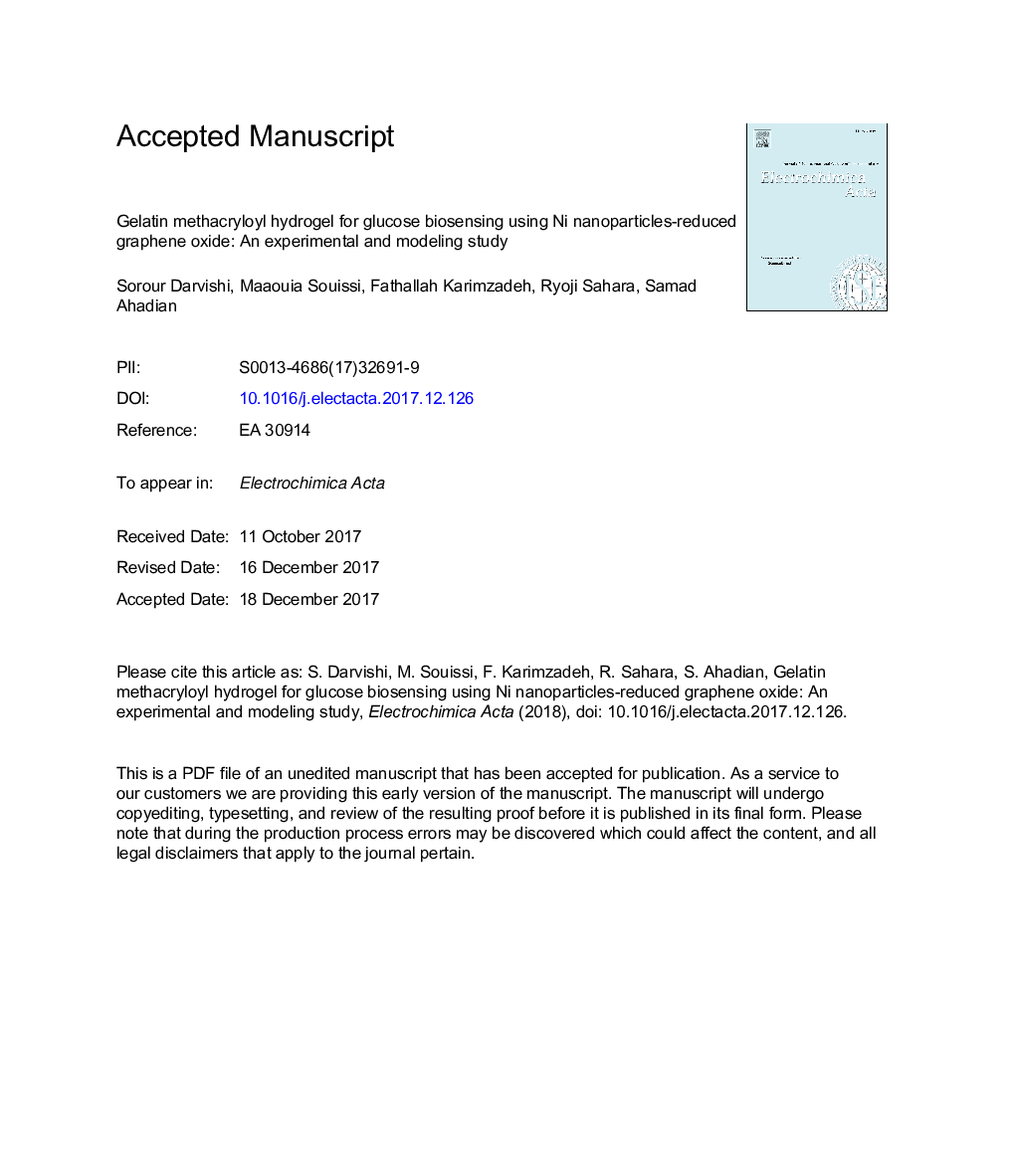| کد مقاله | کد نشریه | سال انتشار | مقاله انگلیسی | نسخه تمام متن |
|---|---|---|---|---|
| 6604615 | 1424096 | 2018 | 27 صفحه PDF | دانلود رایگان |
عنوان انگلیسی مقاله ISI
Gelatin methacryloyl hydrogel for glucose biosensing using Ni nanoparticles-reduced graphene oxide: An experimental and modeling study
دانلود مقاله + سفارش ترجمه
دانلود مقاله ISI انگلیسی
رایگان برای ایرانیان
کلمات کلیدی
موضوعات مرتبط
مهندسی و علوم پایه
مهندسی شیمی
مهندسی شیمی (عمومی)
پیش نمایش صفحه اول مقاله

چکیده انگلیسی
A three-dimensional (3D) and hybrid hydrogel based on gelatin methacryloyl (GelMA), Ni nanoparticles (Ni-NPs), and reduced graphene oxide (RGO) (GelMA:Ni-RGO) was synthesized for enzymeless glucose sensing. Hybrid GelMA:Ni-RGO hydrogel was characterized by scanning electron microscopy (SEM), X-ray diffraction (XRD), Fourier transform infrared spectroscopy (FTIR), and Raman spectroscopy. GelMA avoided the agglomeration of Ni-RGO in aqueous solution as it provided hydrophilic functional groups on the surface of nanoparticles. As a result, an interconnected conductive network within GelMA:Ni-RGO was created for effective charge transfer in glucose sensing. GelMA:Ni-RGO demonstrated non-enzymatic responses to glucose oxidation at a low potential of 0.47â¯V with high sensitivity of 0.056â¯mAmMâ1, a wide detection range from 0.15â¯Î¼M to 10â¯mM, and a detection limit of 5â¯nM. Also, no significant interference was observed from potentially interference species, such as ascorbic acid, acetaminophen, and uric acid. The proposed sensor was used for determination of glucose in human blood serum. High electrochemical performance of GelMA:Ni-RGO can be attributed to large electroactive surface area, porous structure, interconnected conductive networks, and synergistic interaction between GelMA and Ni-RGO in 3D hybrid hydrogel. First-principles calculations were employed to reveal molecular interactions of glucose molecule with GelMA:Ni-RGO. The results showed hydrophobic interaction between graphene and GelMA molecule. Ni nanoparticles were adsorbed on graphene as Ni13 nanocluster with icosahedral geometry. Moreover, glucose was effectively adsorbed on the graphene sheet through Ni13 nanoclusters and the adsorption energy was large in the presence of GelMA.
ناشر
Database: Elsevier - ScienceDirect (ساینس دایرکت)
Journal: Electrochimica Acta - Volume 261, 20 January 2018, Pages 275-283
Journal: Electrochimica Acta - Volume 261, 20 January 2018, Pages 275-283
نویسندگان
Sorour Darvishi, Maaouia Souissi, Mahshid Kharaziha, Fathallah Karimzadeh, Ryoji Sahara, Samad Ahadian,